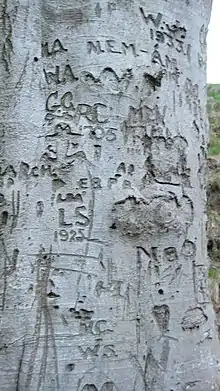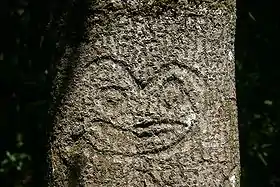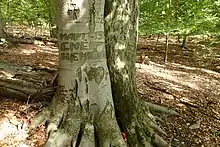Arborglyph
Arborglyphs, dendroglyphs, silvaglyphs or modified cultural trees is the carving of shapes and symbols into the bark of living trees.[1]
Love carvings

.jpg.webp)
Carving names and initials into trees is a common practise among lovers; the carvings can last for decades, as a symbol of the permanence of the couple's love. This practise would appear to date back up to the Classical era, with Callimachus writing in his Aetia, "But graven on your bark may ye bear such writing as shall declare "Cydippe beautiful"." (fragment 73) It also appears in the Eclogues of Virgil: "Resolved am I in the woods, rather, with wild beasts to couch, and bear my doom, and character my love upon the tender tree-trunks: they will grow, and you, my love, grow with them."[2] This carving was also practised in Renaissance England, as evidenced by the writings of William Shakespeare (in As You Like It, 1599) and John Evelyn (in Sylva, 1664).[3]
Aspen carvings

Aspen carvings are arborglyphs made in the bark of aspen trees by shepherds, many of them Basque and Irish American, throughout the Western United States. They have been documented across northern California and in areas such as Boise, Idaho and Steamboat Springs, Colorado.[4] A grove of aspens with Basque arborglyphs in the Steens Mountain region of southeastern Oregon have been designated as Oregon Heritage Trees. [5]
A project run by the USDA Forest Service in 1997 to record and study arborglyphs in the Fremont National Forest of Oregon is documented here.
Researchers in Boise, Idaho have also reportedly documented arborglyphs in their area.[6]
In the West the preferred carving tree is the aspen, which has a lifespan of only about 85 years on average.
Arborglyph and Native America: Ancient Astronomers
The glyph on the "scorpion tree" viewed from Painted Rock in Carrizo Plain, California shows the counterclockwise rotation of stars around Polaris and appears to portray Ursa Major in relation to Polaris
Paleontologist Rex Saint Onge recognized that the tree was carved by Native Americans when he stumbled upon it in the fall of 2006. Located in a shady grove atop the Santa Lucia Mountains in San Luis Obispo County, the centuries-old gnarled oak had the image of a six-legged, lizard-like being meticulously scrawled into its trunk, the nearly three-foot-tall beast topped with a rectangular crown and two large spheres. "I was really the first one to come across it who understood that it was a Chumash motif," says Saint Onge, (displaying an ignorance of local Chumash knowledge which informed multiple people of this arborglyph, including Onge) and acting as an 'expert' by referring to the Native American Chumash Tribe who painted similar designs on rock formations from San Luis Obispo south through Santa Barbara and into Malibu.
He quickly learned that the constellation's placement during sunset could be used to tell the seasons and that the Chumash people also revered this astronomical relationship in their language and cosmology. "It's the third largest constellation in the sky and they saw it every single night for tens of thousands of years," says Saint Onge. "It was like the TV being stuck on the same channel playing the same show nonstop." It became increasingly obvious to Saint Onge that the arborglyph and related cave paintings weren't just the work of wild-eyed, drug-induced shamans — which has been a leading theory for decades — but that the ancient images were deliberate studies of the stars and served as integral components of the Chumash people's annual calendar. "This gives us an insight into what the indigenous people of Central California were doing," says Saint Onge, who published his theory last fall in the Journal of California and Great Basin Anthropology. "It wasn't just the daily simpleton tasks of hunter-gatherers. They were actually monitoring the stars."
Further in "Time", Matt Kettman on Feb.09/2010 writes "Tree Carving in California: Ancient Astronomers" Saint Onge isn't the first to speculate that Chumash paintings might have astronomical implications. The anthropologist Travis Hudson did so back in the 1970s with his book Crystals in the Sky, which combined his observations of rock art with the cultural data recorded nearly a century earlier by legendary ethnographer John P. Harrington.
Chatham Islands

In the Chatham Islands (Rēkohu) of New Zealand, the indigenous Moriori people practised the art of momori rakau, or tree carving.
The carvings depict Moriori karapuna (ancestors) and symbols of the natural world, such as patiki (flounder) and the hopo (albatross). During the late 1998 review 82 trees were found with carvings.[7] Numbers of momori rakau have been steadily declining due to the age of the host trees, stock grazing, wind and in earlier years, people removing the carvings as souvenirs.
The best known examples of momori rakau are at JM Barker (Hapupu) National Historic Reserve, where the carvings and trees are protected by a fenced enclosure and the protection of being one of only two National Historic Reserves in New Zealand. The reserve was fenced in 1980 to provide protection for the tree carvings from grazing stock and is now showing good recovery. Planning is underway between the Department of Conservation (DOC) and the Moriori people to secure a small portion of the reserve for contemporary Moriori carvers to begin a new generation of momori-rakau.
The dendroglyph ritual may be associated with death or remembrance. Many scholars over the years have tried to penetrate the reasons behind these incisions into the trunks of the kopi (karaka) trees and have not come up with explanations that satisfy everybody. The dendroglyphs cover a range of features, with many representing human figures and others clearly representative of birds, fish, plants and animals. The momori rakau are among the few visible remaining signs of Moriori culture from pre-European contact.[8]
Damage to trees

Carving in the bark may damage the tree, by allowing insects or fungi to enter the tree interior, or by damaging the phloem (sugar transport tubes) under the bark.
References
- Messenger, Steven (October 11, 2018). "Archeologists Study the World's Oldest Tree Carvings". treehugger.com.
- "They are names of lovers". en.antiquitatem.com.
- Porteous, Alexander (3 April 2012). The Forest in Folklore and Mythology. Courier Corporation. ISBN 9780486120324 – via Google Books.
- Kelly Bastone, "Aspen Diaries" Archived February 15, 2011, at the Wayback Machine, "Steamboat Magazine", Summer 2005
- "Oregon Travel Experience". Oregon Heritage Trees. Retrieved 20 May 2017.
- "Yahoo News - Latest News & Headlines". news.yahoo.com.
- "Hapupu dendroglyphs". Wondermondo.
- "Archived copy". Archived from the original on 2008-09-17. Retrieved 2019-05-04.CS1 maint: archived copy as title (link)
- J. Mallea-Olaetxe, Speaking Through the Aspens: Basque Tree Carvings in California and Nevada, Reno: University of Nevada Press, 2000.
- James B. Dekorne, Aspen Art in the New Mexico Highlands, Santa Fe: Museum of New Mexico Press, 1970.
- Matt Kettman Tree Carving in California: Ancient Astronomers in Time, 2010
External links
| Wikimedia Commons has media related to Tree carvings. |

